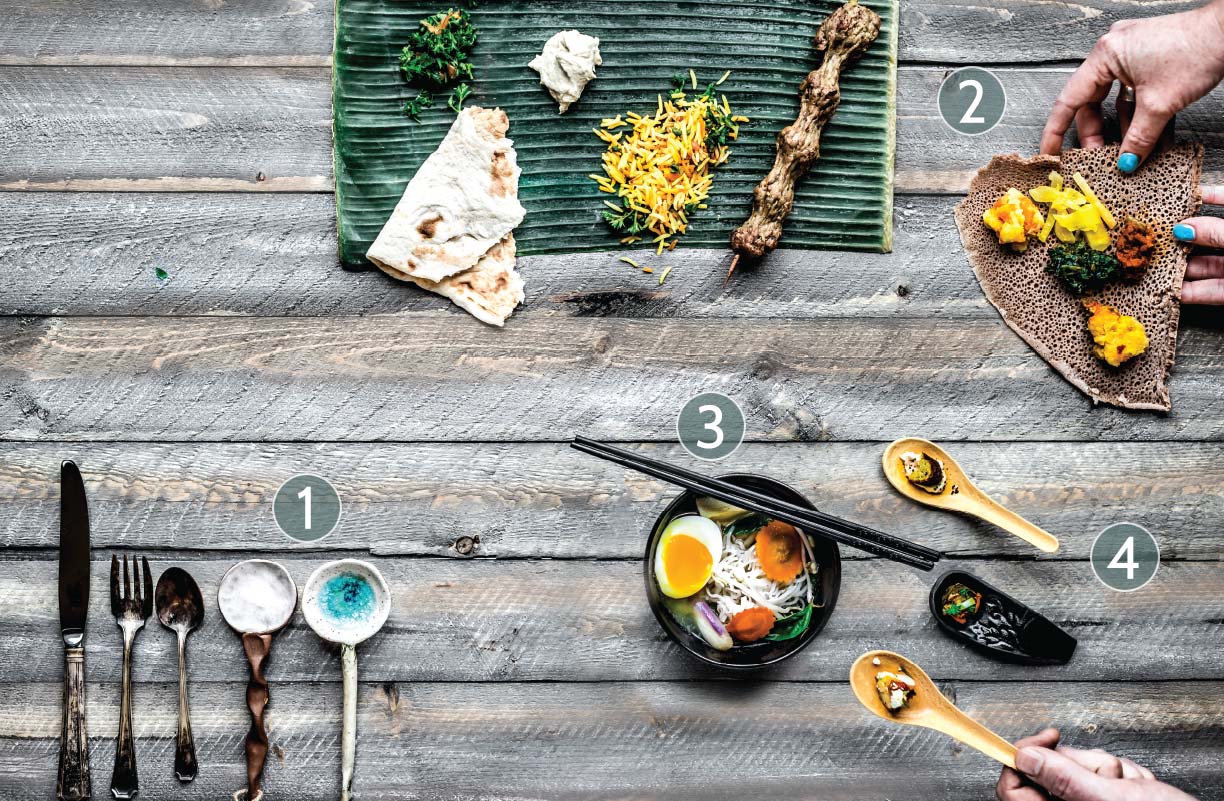The Fork Not Taken - Eating Utensils from Around the World
When we think about global cuisines, we often consider food in terms of difference. And the means by which people deliver food to their mouths whether by forks, spoons, chopsticks, flatbreads or fingers often signals that difference the most. Custom and culture can and do shape the variety of ways people eat.
Yet eating around the world isn’t always about what’s different it’s also about what’s the same. Consider the words of Dr. Margaret Visser, cultural anthropologist and author of The Rituals of Dinner: “Food is never just something we eat . . . we use eating as a medium for social relationships: Satisfaction of the most individual of needs becomes a means of creating community.”
Here’s a closer look at some of the most common ways people around the world eat their food and create community.
1 FORKS, SPOONS & KNIVES
*Pottery spoons by Gravesco Pottery GravescoPottery.com
In Thailand, most people eat with a spoon in the right hand and a fork in the left hand, using the fork to move food onto the spoon. Chopsticks tend to appear only alongside noodle dishes.
In the Philippines, forks and spoons function in a similar way. But at a traditional Kamayan feast, a Tagalog word that translates to “by hand,” a bounty of Filipino dishes sits atop banana leaves and everyone around the table gathers bites of food and rice with their hands.
Forks, knives and spoons may reign as the most common cutlery in the United States, but we still eat plenty of hand-held foods simply for the sake of convenience and speed.
When we think about hamburgers, French fries and corn on the cob, eating with our hands doesn’t seem so different after all.
2 FINGERS & FLATBREADS
*Yemeni food includes hummus, tabbouleh, lamb shawarma, rice, naan bread
*Ethiopian combination plate includes yebeg alecha, doro wett, sega wett, misir wett, spinach, yellow beans, carrots and green beans eaten on injera bread
Although dining customs across India vary regionally, eating with the right hand is traditional and common. Roti and naan flatbreads also hold bites of food scooped from communal platters.
Traditional Ethiopian cuisine is served with a large, slightly spongy flatbread called Injera, made from the ancient grain teff. The thin injera tears easily to scoop up individual bites.
Yemeni cuisine favors two types of flatbreads: malooga and lahoh. Malooga often pairs with savory dishes, like those that include beans or eggs, while the spongier sourdough lahoh complements soups and curries.
3 CHOPSTICKS
*Tofu vegetable pho with five-minute egg
The word “chopsticks” appears to be an English-language version of the Chinese pidgin “chop chop,” meaning “quickly." Invented in China, chopsticks are popular in countries across East Asia, such as Korea, Vietnam, Cambodia, Malaysia and Singapore.
Chopsticks are the most frequently used utensils in Japanese cuisine - just don’t stand the chopsticks up in a bowl of rice. What makes this move a social faux pas? In Japanese burial customs, the deceased’s rice bowl is placed next to the coffin with a pair of chopsticks standing upright. So instead, place the chopsticks together parallel to the edge of the table when not in use, or use a chopstick rest.
4 EDIBLE CUTLERY
*Amuse bouche spoon by Gravesco Pottery GravescoPottery.com
*Edible spoons by Bocado BocadoProducts.com
The disposal of single-use eating utensils contributes to the plastic waste crisis. To reduce the carbon footprint left by these wasteful utensils, companies around the world have started developing biodegradable and edible cutlery that can be eaten at the end of the meal.''
India-based company Bakeys molds spoons and forks from a mixture of sorghum, rice and wheat flours. The spoons even come in three flavors: savory, sweet and plain. U.S. company Bocado makes edible spoons targeted toward one-bite appetizers.





